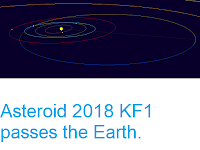Asteroid 2004 LB passed by the Earth at a distance of about 18 954 000
km (48.3 times the average distance between the Earth and the Moon, or
12.7% of the distance between the Earth and the Sun), slightly after 2.00 pm
GMT on Wednesday 6 June 2018. There was no danger of
the asteroid hitting us, though were it to do so it would have
presented a significant threat. 2004 LB has an estimated
equivalent
diameter of 90-280 m (i.e. it is estimated that a spherical object
with
the same volume would be 90-280 m in diameter), and an object at the
upper end of this range would be predicted to be capable of
passing through the Earth's
atmosphere relatively intact, impacting the ground directly with an
explosion that would be about 60 000 times as powerful as the
Hiroshima
bomb. Such an impact would result in an impact crater about 4.5 km
in
diameter
and devastation on a global scale, as well as climatic effects that
would last years or even decades.
The calculated orbit of 2004 LB. Minor Planet Center.
2004 LB was discovered on 7 June 2004 by the Lowell Observatory Near-Earth-Object Search, at Anderson Mesa Station, near Flagstaff, Arizona. The
designation 2004 LB implies that it was the second asteroid (asteroid B)
discovered in the first half of June 2004 (period 2004 L),
2004 LB has an 394 day orbital period and an eccentric orbit
tilted at an angle of 37.3° to the plane of the Solar System, which
takes it from 1.00 AU from the Sun (i.e. the average distance at
which the Earth orbits the Sun) to 1.11 AU from the Sun (i.e. 111% of
the
average distance at which the Earth orbits the Sun). It is therefore
classed as an
Apollo Group Asteroid (an asteroid that is on average further from the
Sun than the Earth, but which does get closer). This means that close
encounters between the asteroid and Earth are extremely common, with the
last having occurred in November 2017 and the next predicted
in December 2018. As an asteroid probably larger than 150 m in diameter
that occasionally comes within 0.05 AU of the Earth, 2004 LB is also
classified as a Potentially Hazardous Asteroid.
See also...
Follow Sciency Thoughts on Facebook.







